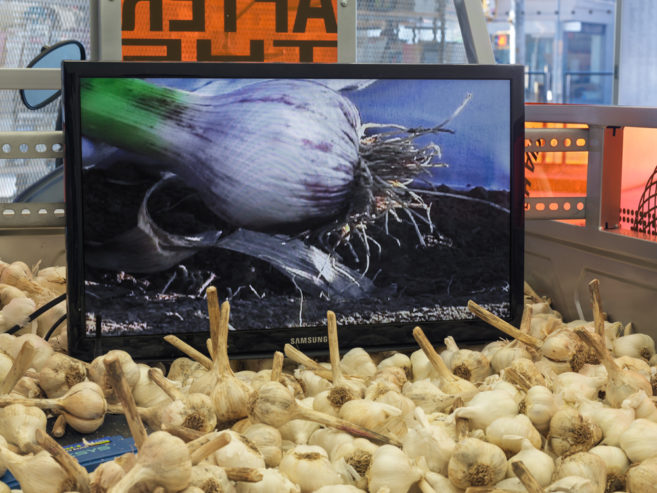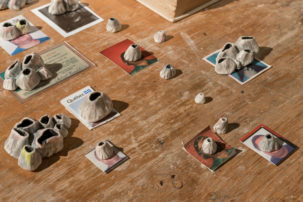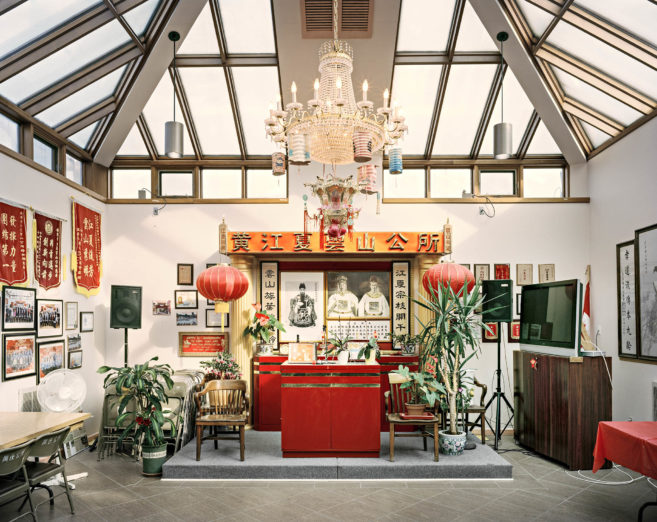This summer in cities and towns across Saskatchewan the Dunlop Art Gallery, along with several partners and municipalities, presents “Roadside Attractions,” a province-wide public art project. Artists from the province and across the country—including Mary Longman, Divya Mehra, Couzyn van Huevelen, Karen Tam, Vicky Sabourin and Alison Norlen—were commissioned to make public artworks that responded to local histories and geographies. The distance between the works was an invitation for viewers to journey through Saskatchewan’s scenic landscape and to encounter a range of installations, sculptures and conceptual projects embedded in various communities, from Estevan in the south to Cumberland in the north.
In this conversation, Jennifer Matotek, director/curator of Regina’s Dunlop Art Gallery, describes the highlights and challenges of this unique summer art project.
Yaniya Lee: So, how did this project begin? You were working with 9 other galleries across Saskatchewan, right?
Jennifer Matotek: We talked about what we could do together and what would be interesting. I proposed this idea of a province-wide sculpture project. Other countries do stuff like that: think about the Münster Sculpture Project or even, to some extent, the Venice Biennale or Documenta, more biennial models of working. We thought if we did something like that in Saskatchewan, but that it was a one-time thing rather than biennial—what would that be, what would it look like?.
Each gallery and cultural organization that we are partnering with brought proposals of artists that they wanted to work with or commission. Since the Dunlop Art Gallery mandate is Canada-wide, we looked at artists from outside the province to create public artworks that would appear on the route between the larger cities, placing works of public art in smaller communities that might have a cultural centre, or might have a museum, but usually would not have public art on the scale that we were proposing.

Mary Longman, Fire Starter and Time Keeper, 2018. Photo: Carey Shaw.

Sculpture installation by Alison Norlen, 2018. Photo: Carey Shaw.

Work by Michel Huneault, 2018. Photo: Carey Shaw.
YL: Could you tell me about a couple of the projects that ended up being significant?
JM: Sure, Sâkêwêwak Artists’ Collective commissioned a really nice work by Dr. Mary Longman. Its called Fire Starter and Time Keeper (2018) and it’s on display at Wanuskewin Heritage Park in Saskatoon. It honours Indigenous traditions around the making of fire, and culture, tradition, history and resilience. It’s a really beautiful piece that, essentially, is a very large firestarter surrounded by stones. The four directions are reflected in the stones that make up the circle. Wanuskewin is such a great place for it because the work is about the resiliency of Indigenous people and that’s what Wanuskewin, as part of their mandate, is really all about
Alison Norlen worked with Estevan Art Gallery and Museum. The City of Estevan was the first or second location for Dairy Queen in the province. It’s kind of a big deal! So she worked with the public during their county fair to build a giant Dairy Queen-looking ice cream cone.
YL: That sounds like very traditional public art: large versions of things that are set up between towns, or as attractions for certain towns.
JM: Exactly. But what’s interesting about these is they end up touching on the histories of the communities in relevant ways, which is really nice. The roadside attractions that the public is used to seeing and thinking about as art are often just large versions of everyday objects. This was more specific, and more reflective of the local communities.
YL: I was really interested in the driving aspect of “Roadside Attractions.” The description of the project on the website implies a sort of journey. Could you talk about the role of driving in the life of people who live in the prairies, and Saskatchewan in particular?
JM: Here in Saskatchewan driving is such a daily part of everyone’s existence, even in most of the larger cities. To do a project like this that actually reflects the experience of living here, you can’t not have driving be a part of it.
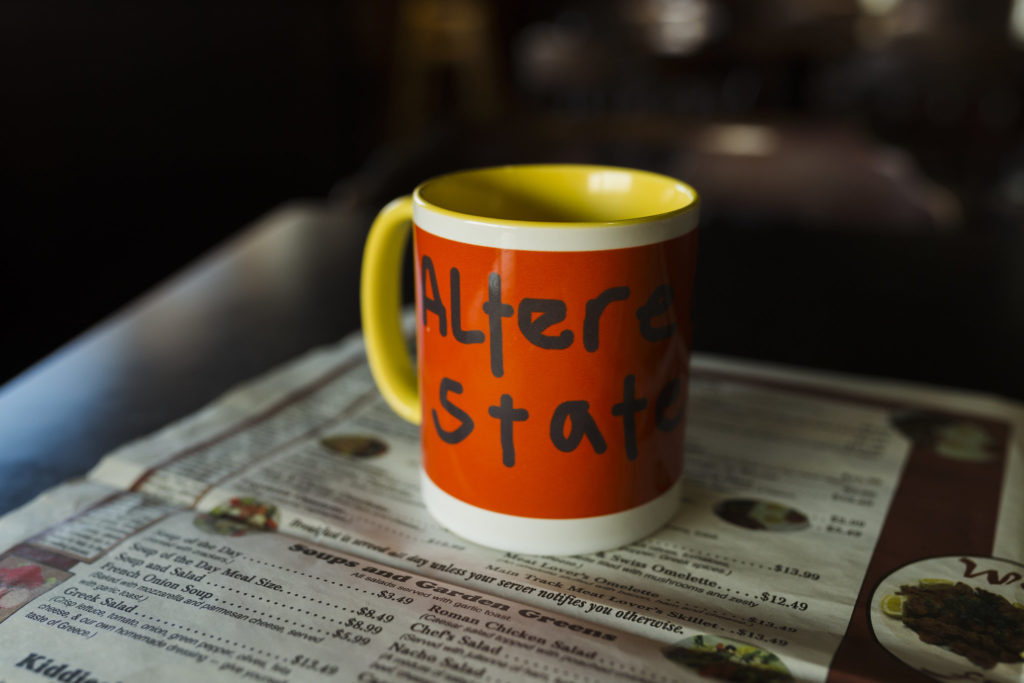
Divya Mehra, World Famous, Come in We’re Open (Thoughts on a Better Tomorrow), 2018. Photo: Carey Shaw.

Divya Mehra, World Famous, Come in We’re Open (Thoughts on a Better Tomorrow), 2018. Photo: Carey Shaw.

Babak Golkar, Made In Canada, 2018. Photo: Carey Shaw.

Barbara Meneley, Cartographies for the Next 150, 2018. Photo: Carey Shaw.

Barbara Meneley, Cartographies for the Next 150, 2018. Photo: Carey Shaw.

Work by Kara Uzelman, 2018. Photo: Carey Shaw.
YL: What are the unique features of the province that are brought to light through this project?
JM: Curatorially, the framework that I was working from with the outdoor sculptures, like many of the other curators, was to really look at the geography, or the land, and the people and the history of the places where they were exhibiting.
One really nice piece, that I think reflects that, is by Karen Tam, whose work looks at the history of Chinese restaurants on the Prairies and the entrepreneurs that ran those restaurants. At the time, there were all kinds of archaic laws, particularly in Saskatchewan, that said a white person couldn’t be working for a Chinese person who owned a business. So there’s this whole strange history of what it means to be a newcomer and an entrepreneur in Canada. When Tam was in Saskatchewan and on the West coast working with archives, she came across the ledgers of a Chinese-Canadian businessman who owned a series of cafés across the Prairie provinces. The artwork that she put together, a large bronze piece called Blood and Tears (2018), is about looking at these untold histories in Canada.
Divya Mehra’s work looks at that in a different way as well. Her mug piece World Famous, Come in We’re Open (Thoughts on a Better Tomorrow) (2018) is available in two different locations in Weyburn. If you were driving through, from West to East or East to West, you would be able to acquire these mugs. One of them says “TOURIST ???” and the other says “ALTERED STATES”. There’s a way you could read them, thinking of it from a truck driver’s perspective, but there are also so many other levels you could read the work on. You know, Who’s a tourist? Who belongs, who doesn’t?
YL: Was the mix of artists from inside and outside the province important?
JM: We wanted to make sure that we were supporting artists who are from Saskatchewan to create work that, otherwise, they wouldn’t have the opportunity to make. So the idea of looking at yourself, something that’s self reflexive, was really important for us. We made sure that artists from across Canada were involved because I think it’s also important to have the outside looking in. We wanted to make sure that we had that, because often an external perspective will bring to light something that you just don’t notice about yourself, or think about.
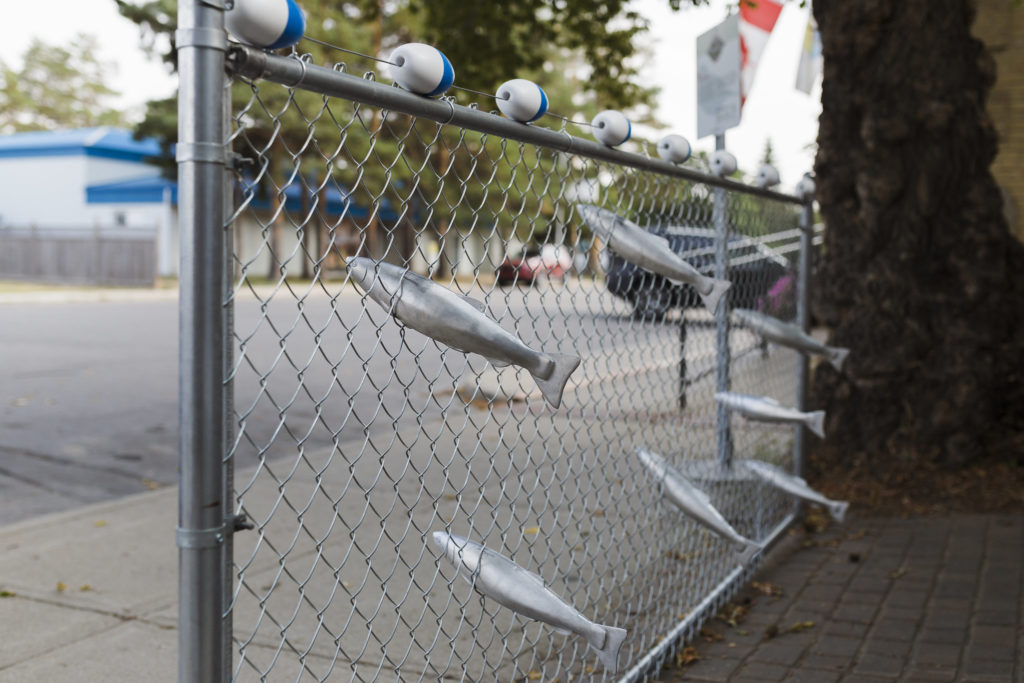
Couzyn van Heuvelen, Nets, 2018. Photo: Carey Shaw.

Work by Vicky Sabourin, 2018. Photo: Carey Shaw.
YL: Could you speak about how some of the out-of-province artists reacted to being there— the ones who came and visited and worked onsite?
JM: For a lot of the artists, their first introductions with what the landscape looked like here was through Google Street View. And that was kind of their first location scout. That’s something that would have been unimaginable even a decade ago. Having that be the starting point for a few artists really changed the way that they saw their site and thought about the history of the places they were exhibiting in.
Vicky Sabourin, for example, is based in Quebec. As someone from Eastern Canada and used to a different geography, she had a very visceral reaction to how flat the landscape was. She’s exhibiting in Montmartre, which is a community that was named by some French settlers. Looking at the landscape and how flat it is, and thinking about what that experience must have been like—for her response to the project she came up with a text piece that really reflected her reaction. She was imagining what it must have been like for people from away to come to this new landscape, and how it must have felt going from living in the mountains and hills to living on flat prairie ground.
Then you have someone like Couzyn van Heuvelen, who did the piece that’s at Fort Qu’Appelle. He is an Inuit sculptor and what he’s doing is looking at his history growing up, which was fishing, and how important that is, culturally and family-wise for him. He was able to exhibit in a place where Hudson’s Bay had their location, and think about the fact that those lakes around Fort Qu’Appelle have such an important role in the history of the community and how people in Saskatchewan know and think about that location. So there were also very personal ties between the artists, their practices and the locations they exhibited in.
YL: Could you talk about some of the challenges of bringing the project together?
JM: I mean, first of all there’s the distance—just the geographical diffuseness of the project was a real challenge. You’ve got your installers driving quite long distances to go and install the work. It was also very challenging to communicate with a lot of our partners. We linked up with a lot of municipalities right away, who are so excited about what was happening, and then we had a handful of other ones who were less excited and their interest in the project fell away. And you also have turnover in terms of people who are working for municipalities and smaller galleries: the person that you start talking with a year before isn’t necessarily the same person you talk to a year later. In a couple of cases works had to be relocated because of logistical or conceptual or political concerns.

Joi T. Arcand, Listen to the land (Mother Earth), she will tell you that the sacred promises will never cease, 2018. Photo: Carey Shaw.

Work by Eleanor King, 2018. Photo: Carey Shaw.

Work by Laura St. Pierre, 2018. Photo: Carey Shaw.
YL: Could you talk about the audio component?
JM: Sure. When we were conceiving the project we thought, “Oh my gosh, this is a journey—this is potentially 20 hours of people driving in a car!” We thought it would be very important to think about the drive as a part of the project, so conceptually it made sense to think about having some sort of soundtrack, or podcast-style content that would accompany people on the drive. We thought it would be important to interview the artists who were participating in the project, and also interview people from Saskatchewan who work in the arts. We wanted to expand it beyond the artists to have people think about what Saskatchewan is, and what it means to people. We also worked with the Unheard Collective in Saskatoon to create sound art for the drive. We wanted to really make sure that the audio component provided a multifaceted experience for people as they’re driving along.
YL: What’s been the general reaction from audiences?
JM: I think that there are some people who are quietly looking at it and we’ll just never hear from them, and maybe that’s okay. There was a couple here over the weekend from Calgary who were doing the drive who said that they were loving it, and they also called it a journey, which I thought was interesting. So I think there’s something to that, the idea that maybe it is a journey, it’s not just something that you look at: it’s something that you experience. It almost becomes time-based in a weird way because when you include the driving time, the art becomes kind of a break from your driving and that isn’t the typical way that we think about or experience public art.
YL: Could you talk about the legacy—do you think there will be a lasting effect to this project? Because it is quite short, it’s not too short, but it’s only for a summer and then the projects will be taken down.
JM: I’m not sure what the legacy is going to be. I hope that people take away the idea—especially in the smaller communities—that public art can be a lot of different things, and maybe expand their understanding of what contemporary art is and what art can be. This is especially relevant for small communities or farm towns that maybe don’t have contemporary art galleries anywhere near them. I’m hoping too that it has expanded the artists’ practices by allowing them to think about their work in different ways. I hope they’ve had a good experience and that they’ve learned something about Saskatchewan.

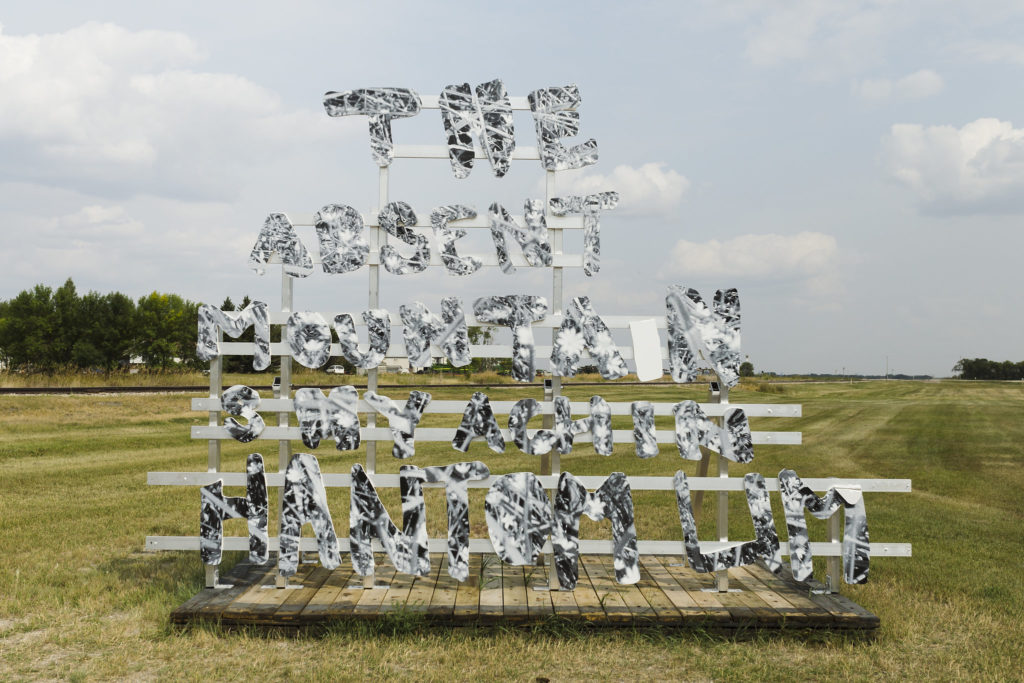 Work by Vicky Sabourin, 2018. Photo: Carey Shaw.
Work by Vicky Sabourin, 2018. Photo: Carey Shaw.
